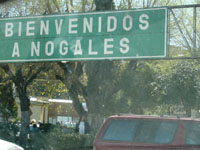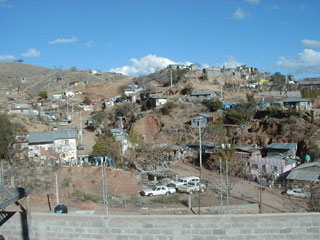
A Different Trip, A Different Outcome
 I am pretty familiar with Mexico; I have been to
Mexico on several occasions, most of the time to visit family. I even
lived in Mexico as a young girl. Growing up in Southern California, I
got familiar with the Tijuana border. My family and I would often take
trips to shop or go camping in the beaches of Baja California and even
visit family close to the Mexican border. When I found out our class
was going to take a trip to Nogales, Mexico I thought of it as just
another visit to a familiar place. Little did I know I would leave the
city of Nogales with an insight outside of what I usually take with me
on each visit to Mexico, this time I would take something different.
I am pretty familiar with Mexico; I have been to
Mexico on several occasions, most of the time to visit family. I even
lived in Mexico as a young girl. Growing up in Southern California, I
got familiar with the Tijuana border. My family and I would often take
trips to shop or go camping in the beaches of Baja California and even
visit family close to the Mexican border. When I found out our class
was going to take a trip to Nogales, Mexico I thought of it as just
another visit to a familiar place. Little did I know I would leave the
city of Nogales with an insight outside of what I usually take with me
on each visit to Mexico, this time I would take something different.
Before the trip I was very familiar with Mexico as a third world country. My father comes from an impoverished town in Mexico and as a child living in Mexico I was often exposed to the lifestyle and I continue to be exposed through visits with family. Before leaving on the trip I was also familiar with border towns and the difference between border towns and towns further south. Although this trip was my first trip to Nogales, I went with the understanding that the Nogales border was familiar to many of the other U.S.-Mexico borders, including Tijuana. What I did not know and always questioned was why? Through the trip I began to get a glimpse at why and I began to see the reason behind such high rates of migration.
To begin with I got a better understanding of the low economic status of many of the people in Mexico. Although I have a lot of family that live in poverty I never could find it in myself to ask them about their current situation. In taking this trip I go the opportunity to ask questions to people that live in the same manner as some of my family. I was astonished to learn the high cost of living in Mexico and how it compared to the United States. The two ladies I ate lunch with really placed things into perspective. They mentioned the expensive cost of utilities, and the cost of obtaining a visa, which is mostly used to cross the border to buy things of better quality and better prices ($60-Mexican visa, $100-American visa). Looking at the expenses in terms of American money it seems reasonable, but when you think of the wages paid in Mexico and when you think that every ten pesos is equivalent to one dollar you begin to see how expensive the cost of living really is. These answers not only provided me with an insight into the life of many poor individuals, but more importantly it provided me with an insight in to the lives of many of my family members.
Before this trip I had a brief understanding of the Maquiladora industry from readings. Just from the readings my initial impression of Maquiladoras was negative. Although I know Maquiladoras have provided work for Mexicans I also understood that many of the jobs have proven to be hazardous. In an article titled “We Are Not Machines,” Maria Torres explains her gratitude and criticizes Maquiladoras, “I am grateful that there is work…when they come they should bring justice with them. They should bring protection and concern for our health.” After visiting a Maquiladora my impression did not change for the better. In visiting Curtis Industries I was astonished at the low wages offered compared to the labor intensive work the employees do. The employees earn about ten dollars for an entire day. I was also amazed to find out that within the next four months, Curtis Industries, an American owned company, will have 98% of their production done in Mexico. There is definitely a reason why this company is choosing to do this and the answer is obvious; cheap labor for maximized profits.
In addition to getting a better understanding of the Maquiladora industry I also was able to understand the effects of NAFTA. I went to Mexico with the understanding that NAFTA has cost many jobs, almost 40,000 jobs in the United States, and that NAFTA was also responsible for placing eight million Mexicans in a lower status. I also understood that NAFTA only benefited large companies since it provided them with free trade and low wages. It was Kiko Trujillo, the Borderlinks Mexico Director, who really placed the effect of NAFTA into perspective for me. He mentioned that NAFTA does what large companies do to mom and pop shops; puts them out of business. With these words I understood the effect of NAFTA on agriculture and small businesses in Mexico.
It is amazing to see how all these
factors contribute to the migration of Mexicans within Mexico and the
United States. It is due to the high cost of living and low wages that
many Mexicans migrate from southern states to the border town of Nogales
where foreign companies offer wages above minimum wage. However, since
the cost of living in border towns is above average it is no surprise
that the thought of migrating to a first world country seems like a
great solution when wages only go so far and people are continually
living under very poor conditions.

To say the least this trip proved to be very different from my usual trip to Mexico. This trip provided me with much more than I anticipated. Not only has it provided me with a better insight on Mexican migration issues but it also has provided me with a better insight of what my family members experience and have experienced.